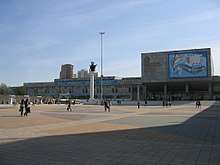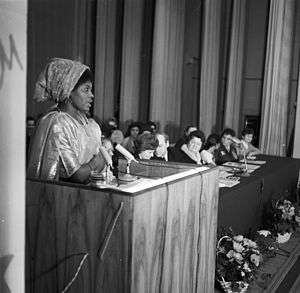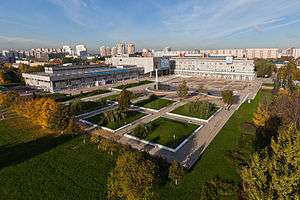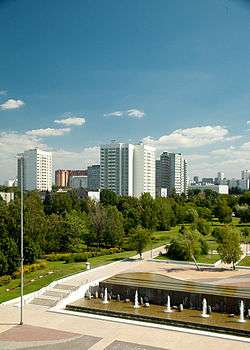Peoples' Friendship University of Russia
The Peoples' Friendship University of Russia (Russian: Российский университет дружбы народов Rossiysky universitet druzhby narodov), also known as RUDN University, is an educational and research institution located in Moscow. It was established in 1960 to provide higher education to Third World students. It became an integral part of the Soviet cultural offensive in nonaligned countries.[1]
Российский университет дружбы народов | |
 | |
| Motto | Scientia unescamus (Let us be united by knowledge) |
|---|---|
| Type | Public |
| Established | 5 February 1960 |
| Rector | Vladimir Filippov |
Administrative staff | 5000 |
| Students | 21,484 |
| Address | 117198, Moscow Miklukho-Maklaya str. 6 , , |
| Campus | Urban |
| Affiliations | IFPU |
| Website | www |

History


The Soviet government founded the university on 5 February 1960. Its stated objective during the height of the Cold War was to help developing nations. Many students from developed countries also attended the university. On 22 February 1961, the university was named Patrice Lumumba University after the Congolese independence leader Patrice Lumumba, who had been killed in a coup that January. The stated purpose for establishing the university was to give young people from Asia, Africa and Latin America, especially from poor families, an opportunity to be educated and to become qualified specialists.[2] The organizations that have been mentioned as founders of the university are the All-Union Central Soviet of Trade Unions, the Soviet Afro-Asian Solidarity Committee, and the Soviet Associations Union of Friendship and Intercultural Relationship.[3]
Professor Sergey Vasilievich Rumiantsev, Doctor of Engineering, was the first Rector of the University. He took an active part in the foundation of the university and remained its Rector till 1970. In 1960, Russian language studies for international students started at the preparatory Faculty. On 1 September, Russian language studies were introduced at the six main faculties of the PFU (Engineering faculty, faculty of History and Philology, Medical faculty, Agricultural faculty, faculty of Science, faculty of Law and Economics).
The first 288 students from 47 countries graduated in 1965. Around that time international construction teams started to appear and the first student teams of KVN were organized (later on, the PFUR KVN team became one of the most famous teams in the country).
Professor Vladimir Frantsevich Stanis, Honored Scientist of the Russian Federation (RF), Doctor of Economics, became the second Rector of the PFU. It was he who proclaimed the “cult of knowledge” at the University, heading it from 1970 to 1993. In this period, the Peoples’ Friendship University became a major international scientific and educational centre. In 1972, Stanis proceeded to the extension of the duration of studies, which until then were shorter, along the lines of mainstream Soviet universities. At the Faculty of Medicine, for instance, the duration of studies was extended from five to six years.[4] By 1975, the University had more than 5,600 graduates, among them 4,250 people from 89 foreign countries. That year, the University was awarded the Peoples’ Friendship Order for achievements in training experts for Asian, African and Latin America countries. The University’s name was changed to the Peoples’ Friendship University of Russia on 5 February 1992 by the RF Government, which is considered the University’s founder.
From 1993 to 1998, PFUR was headed by Vladimir Filippov, a 1973 graduate of Patrice Lumumba PFU. He held the position of Minister of Education of the Russia from 1998 to 2004, and was appointed the Prime Minister’s Assistant on Culture and Education in 2004. In the period from 1998 to 2005, PFUR was headed by Professor Dmitry Petrovich Bilibin, a 1966 graduate of Patrice Lumumba PFU, Honored scientist of the RF, Doctor of Medical Sciences. He was acting Rector till 2004, and was elected Rector of the University in 2004. Professor Filippov, Doctor of Sciences in physics and mathematics, member of the Presidium of the Russian Academy of Education, was reelected Rector of the PFUR on 4 March 2005, and has headed the University since then.
The 1990s saw the creation of new faculties and Institutes: the Ecological faculty, the faculty of Economics, the faculty of Law, the Philological faculty, the faculty of Humanities and Social Sciences, the faculty of Refresher Training for Health Care Professionals, the Institute of Foreign Languages, the Institute of Distance Learning, the Institute of Hospitality Business and Tourism, and the Institute of Gravitation and Cosmology. The University also developed systems of pre-university and further professional education. 2006 was marked by the 50,000th diploma awarded by PFUR, received by José Atinensia Villagómez, an Engineering faculty graduate from Ecuador.
The university's current Russian name is "Российский университет дружбы народов", which could be translated as "Peoples' Friendship University of Russia" or, more directly, as "Russian University of the Friendship of Nations". The English-language version of the university's website, however, uses the name "RUDN University", with the acronym RUDN derived from the Russian name transliterated into English ("Rossiiskii Universitet Druzhby Narodov").[5] Nonetheless, it remains most common in English to use the name "Peoples’ Friendship University of Russia" or the abbreviation "PFUR".
The Peoples’ Friendship University of Russia is one of the leading state higher educational institutions of Russia. The university has a multiprofile structure of faculties and majors. More than 77,000 graduates of the university work in 170 countries, among them more than 5,500 holders of PhD and Doctorate degrees. Lecturers train specialists in 62 majors and lines of study. More than 29,000 graduate and postgraduate students from 140 countries studying at the university as of 2014. They represent more than 450 nations and nationalities of the world. It has a team of 4,500 employees, among them 2,826 teachers. The university intellectual fund comprises more than 870 author's invention certificates and 150 patents of the Russian Federation in practically all fields of the university's scientific research.
Many foreign and Russian political and public figures, scholars and scientists have become PFUR Emeritus Professors. They include the presidents of Namibia, Angola, Sri Lanka, the South African Republic, Gabon, Guyana and Nigeria; the prime ministers of Bangladesh and Kazakhstan; a UN Chief Executive Officer on Education, Culture and Science; and a Director of CEPES.
Organization



- Agrarian Technological Institute [6] was founded in 1961. It has about 1,000 students and 5 teaching and research departments (The Agrobiological Department; The Agricultural Engineering Department; the Department of Veterinary Medicine; the Department of Technosphere Safety; the Department of Foreign Languages). It has more than 100 teachers, among them 26 DSc (full professors) and 66 PhDs. Students of the Agrarian faculty have a unique opportunity to combine basic natural-science education at the Bachelor’s level with deeper specialization at the Master’s level, including programs on economics and management. Scientists of the faculty are involved in both theoretic and applied fields.
- Faculty of Humanitarian and social sciences[7] was founded in 1996 (after re-organization of the Historical-Philological faculty). It has more than 2,500 students and 12 departments. It has more than 250 teachers, among them 1 corresponding member of the Russian Academy of Sciences, 22 academicians of various public academies of sciences, 66 full professors, and 118 PhDs. The faculty follows traditions and makes use of experience accumulated by the departments during the existence of the University, meanwhile successfully introducing new principles and educational technologies. Modern scientific and technologic innovations are employed in teaching: all classrooms are equipped with multimedia devices; two computer classrooms with laptops and interactive boards have been opened; two classrooms for conference interpreting have been created; exclusive software for conducting research has been purchased. The faculty maintains close ties and cooperates with universities in France, Germany, Spain, the Czech Republic, the United States, Canada, China, Egypt, Syria and Iran. PFUR students participate in academic exchange with partner universities and research centers worldwide. It helps them not only improve professional skills and master foreign languages but also facilitates adaptation to the modern world.
- Engineering academy[8] was founded in 1961. It has more than 2,600 students and 16 departments. It has more than 240 teachers, among them 17 corresponding members and academicians of various academies of sciences, 46 full professors and 110 PhDs. The main aim of the Engineering faculty is to prepare specialists who, apart from their major qualification, could head enterprises and run businesses. Thus, students are given tuition discounts in second degree courses. The most popular fields are law, economics and ecology. The Engineering faculty is polytechnical. Laboratories have modern equipment allowing research on current problems of world and national architecture and town-building.
- Faculty of the Russian language and general educational disciplines[9] was founded in 1960. It has more than 1,000 students and 9 departments. It has about 200 teachers, among them 7 full professors and 62 PhDs. The faculty teaches the Russian language to foreign students so that they can study at PFUR main faculties and other Russian universities. Foreign students have a one-year intensive course of Russian and the basics of subjects they are going to major in. There are 4 departments of the Russian language, departments of mathematics and information science, chemistry and biology, physics, humanitarian disciplines, history and society studies. The faculty has modern laboratories, computer classrooms, video and multimedia equipment. The faculty preserves and improves existing traditions and develops new fields of activity: new educational programs, standards and tests are elaborated, innovational educational technologies and concepts are worked out. Since its foundation more than 20,000 foreign students have been taught at the faculty. Every year more than 1,000 students from more than 140 countries study at the faculty to continue with 62 lines of study and specialties at the main faculties. The department regularly holds methodology seminars; students work in scientific societies and participate in Olympiads and contests. Scholars of the faculty organize international scientific-research conferences on the problems of teaching Russian as a foreign language and interdisciplinary communication.
- Institute for Medicine[10] was founded in 1961. It has more than 2,300 students and 43 departments and 2 independent courses. It has 420 lecturers – 5 academicians and 2 corresponding members of the Russian academy of medical sciences; 24 academicians and corresponding members of social academies, 15 Honored scientists of the Russian Federation (RF), 3 laureates of RF State Prizes, 2 laureates of government State Prizes, 132 full professors and 220 PhDs. The Institute for Medicine PFUR has a first-class reputation both in Russia and abroad; its fame rests on the scientists working at the faculty and the graduates. Nowadays, more than 6400 professionals that have been educated at the Institute for Medicine are working in more than 110 countries of the world. In numerous laboratories with up-to-date diagnostic and research equipment, students attempt penetrating into the mysteries of structure and functioning of the human body and learn how to diagnose diseases and apply innovative methods of treatment. The members of the Institute for Medicine are actively implementing educational programs aimed at teaching new medical technologies to medical staff. Functioning at the faculty are: the Students’ scientific society that helps students become familiar with research from the beginning; the Young medical doctors’ community; the Students’ theatre «Hippocrates», the lecture centre where lectures in literature, music and history are presented. The pre-university education is provided at the «Medik» medical-biological school (preliminary courses). Today, the Institute for Medicine of PFUR is equipped with 14 novel clinical laboratories; in the training process, computer testing and TV broadcasting are used. For refinement in practical treatment, subdivisions of computer tomography, liver fiberscanning and andrology have been created.
- Faculty of Science.[11] It was founded in 1961. It has about 900 students and 16 departments, and about 280 lecturers, among them 65 full professors and 160 PhDs. At the Faculty of Science, a classical combination of specialties characteristic of universities in Europe is practiced. The academic education provided at the faculty allows the graduates to climb the career ladder in various fields. At present, the members of the faculty are not only working out innovative programs for physics and physical informatics, telecommunication systems, nanostructure optics, etc. but designing teaching materials for these disciplines. At the faculty, allied subjects of physical, physicochemical, radio engineering and engineering profiles are taught with the extensive use of up-to-date laboratory equipment. Integration of intellectual, material and technical, technological and organizational resources makes it possible for post-graduate students and scientists of PFUR to carry out scientific research at a modern level.
- Philological faculty[12] was founded in 1996 (after re-organization of the Historical-philological faculty). It has more than 2800 students and 9 departments. It has about 155 teachers, among them 17 corresponding members and academicians, 43 full professors and 120 PhDs. The Philological faculty is a community of scholars and practicing teachers who love language and generously share their knowledge with students and colleagues from Russia and abroad. The scientific life of the faculty is very active: scholars elaborate various trends, apply for and get grants, participate in international, national and branch conferences, seminars and symposia; there are Doctorate dissertation councils for philological, pedagogic and psychological sciences. Thanks to big efforts of the teachers and academicians Russkiy Mir Foundation opened its department inside of RUDN in 2008.[13] Russkiy Mir foundation created by Vladimir Putin in 2007 is a government-funded organization aimed at promoting the Russian language, culture and educational programs abroad.
- Ecological faculty,[14] founded in 1992. It has 514 students and 8 departments. The faculty numbers 80, among them 15 academicians and corresponding members, 35 full professors and 31 PhDs. At the Ecological faculty students have an opportunity not only to master general educational disciplines but also a whole range of special disciplines in the field of system ecology, human ecology, eco monitoring, eco systems management, eco expertise, radioecology and geoinformation technologies. Lectures are given by the leading foreign experts in international ecological projects and ecologists from international companies represented in the Russian market. Teachers of the faculty are involved in eco expertise of international companies as well as projects and programs on geoecology, ecology and ecosystem exploitation.
- Faculty of Economics.[15] It was founded in 1995 (after re-organization of the Faculty of Economics and Law). It has more than 1,500 students, 10 departments and 2 laboratories. It has 160 teachers, among them 10 academicians and corresponding members of various academies of sciences, 24 full professors and 74 PhDs.
- Institute for Law.[16] It was founded in 1995 (after reorganizing the Faculty of Economics and Law). It has more than 1,800 students and 9 departments. It has about 180 faculty members, among them 3 academicians and corresponding members, 32 full professors and 71 PhD’s. Students of the Institute for Law take part in professional legal practices. While working at the Students’ Advisory Bureau at PFUR, students gain experience working with the public and local authorities. In addition, leading Russian lawyers regularly give master classes at the Institute for Law. The training program is aimed at providing special knowledge necessary for the future professional activity. The PFUR Institute for Law is one of the few in Russia offering a master's degree in law. Law students participate in international exchange programs on a yearly basis. They undergo study courses at universities in France, Spain, Italy, the Czech Republic, the USA, Finland, Austria, China and other countries.
- Institute of Hospitality Business and Tourism
Research and development
- Academic-research Institute of Gravitation and Cosmology
- Institute of World economy and business
- Institute of Medico-Biological Problems
The university staff includes about 5,000 employees; among them are 442 professors and Doctors of Science, 807 associate professors and candidates of science, 91 academicians and Corresponding Members of academies of Russia, 50 Honoured workers of Science of the Russian Federation, 56 PFUR teachers and professors are full members of international academies and learned societies, as well as other general employees.
Campuses

- The main campus of PFUR is situated along Miklukho-Maklaya Street starting from Leninsky Prospect in the direction of Volgina Street. On the even-numbered side you can find: The main building of PFUR (called the “Cross”), buildings of the Faculties of Medicine and Agriculture, and also the sport complex, the polyclinic, the archives and the new building of the Faculty of the Russian Language and general educational disciplines, the building of natural sciences and humanitarian faculties hosting the Faculty of Humanitarian and Social Sciences, the Institute of Hotel Business and Tourism (IHBT), the Institute for International Programs (IIP), and the Institute of Supplementary Professional Education's postgraduate department.
- The campus of the Engineering Academy and Faculty of Science. It is located at #3 Sergo Ordzhonikidze Street. The campus consists of several blocks and has historical interest because the building at #3/4 Sergo Ordzhonikidze Street was built in 1913 by Boris Alberti. This is a former parochial secondary school with the church named after Duke Vladimir in 1913-1919.[17][18][19] The building at #3/1 Sergo Ordzhonikidze Street was built in 1930 and was the main house of the Military Academy of the General Staff of the Armed Forces of USSR. The Engineering Academy and Faculty of Physical and Mathematical Sciences started to use this building complex in 1960.
- The campus of the Ecology Faculty. It is located at #8 Podol'skoe Street.
- The campus of the Faculty of Refresher Training for Health Care Professionals. It is located on Leninsky Avenue.
Degrees offered
- Bachelor's degree (4 years of study)
- State Specialist degree (5 years of study)
- Medical Doctor degree (6 years of study)
- Master's degree (2 years of study following B.Sc.)
- Ph.D. (3 years after Master's or Specialist)
- D.Sc. (2–3 years after Ph.D.)
- Summer schools programs (Russian language learning; Short courses, different areas)
Notable Alumni
- Fatima Abdel Mahmoud, Sudanese politician, leader of the Sudanese Socialist Democratic Union
- Abed Elrahim Abu Zakrra, Sudanese writer and poet
- Irina Khakamada, Russian politician
- Vladimir Filippov, former Minister of Education and Science of Russia, current Chancellor of the University
- Ilich Ramírez Sánchez (Carlos the Jackal), Venezuelan terrorist and assassin (expelled)
- Lucy Seki, Brazilian linguist
- Timoleón Jiménez, leader of FARC
- Porfirio Lobo, President of Honduras
- Daniel Ortega, President of Nicaragua
- Michel Djotodia, President of the Central African Republic
- Hifikepunye Pohamba, former President of Namibia from 2005 to 2015
- Anna Chapman, Russian intelligence officer
- Alexei Navalny, Russian lawyer, political and financial activist, and politician
- Bharrat Jagdeo, Former President of Guyana
- Tamar Beruchashvili, Minister of Foreign Affairs of Georgia
- Dieudonné Gnammankou, Beninean historian
- Mahmoud Abbas, President of the State of Palestine and Palestinian National Authority
- Ali Khamenei, Sayyid Ali Hosseini Khamenei, Islamic Republic of Iran Supreme Leader
- Hillary Onek, Minister of Internal Affairs, Republic of Uganda
- Rohana Wijeweera, Sri Lankan Marxist politician, revolutionary and the founding leader of the Janatha Vimukthi Peramuna
References
- Alvin Z. Rubinstein, "Lumumba University--Assessment." Problems of Communism 20.6 (1971): 64-69.
- "Voices from Russia's Cold War 'friendship' university". BBC News. 6 February 2010. Retrieved 6 February 2010.
- Abigail Judge Kret, "'We Unite with Knowledge' The Peoples’ Friendship University and Soviet Education for the Third World." Comparative Studies of South Asia, Africa and the Middle East 33.2 (2013): 239-256. online
- Constantin Katsakioris, “The Lumumba University in Moscow: Higher Education for a Soviet-Third World Alliance, 1945-1991,” Journal of Global History 14, 2 (2019): 281-300. Online Open Access https://www.cambridge.org/core/services/aop-cambridge-core/content/view/8720DF55AA0CEBC782EC8B215AC08D47/S174002281900007Xa.pdf/lumumba_university_in_moscow_higher_education_for_a_sovietthird_world_alliance_196091.pdf
- "Homepage". RUDN University. Retrieved 10 March 2017.
- "Agrarian faculty — RUDN University". Retrieved 16 December 2016.
- "Faculty of Humanitarian and social sciences — RUDN University". Retrieved 16 December 2016.
- "Engineering faculty — RUDN University". Retrieved 16 December 2016.
- "Faculty of the Russian language and general educational disciplines — RUDN University". Retrieved 16 December 2016.
- "Institute of Medicine — RUDN University". Retrieved 16 December 2016.
- "Faculty of Science — RUDN University". Retrieved 16 December 2016.
- "Philological faculty — RUDN University". Retrieved 16 December 2016.
- "Факультет повышения квалификации преподавателей русского языка как иностранного - Главная".
- "Ecological faculty — RUDN University". Retrieved 16 December 2016.
- "Faculty of Economics — RUDN University". Retrieved 16 December 2016.
- "Institute of Law — RUDN University". Retrieved 16 December 2016.
- Register Russian churches
- Register Russian churches
- The photographs of old Moscow
Further reading
- Katsakioris, Constantin, “The Lumumba University in Moscow: Higher Education for a Soviet-Third World Alliance, 1945-1991,” Journal of Global History 14, 2 (2019): 281-300. Online Open Access https://www.cambridge.org/core/services/aop-cambridge-core/content/view/8720DF55AA0CEBC782EC8B215AC08D47/S174002281900007Xa.pdf/lumumba_university_in_moscow_higher_education_for_a_sovietthird_world_alliance_196091.pdf
- Kret, Abigail Judge. "'We Unite with Knowledge' The Peoples’ Friendship University and Soviet Education for the Third World." Comparative Studies of South Asia, Africa and the Middle East 33.2 (2013): 239-256. online
- Rubinstein, Alvin Z. "Lumumba University--Assessment." Problems of Communism 20.6 (1971): 64-69.
External links
| Wikimedia Commons has media related to Peoples' Friendship University of Russia. |
- Official website
- English website at the Wayback Machine (archive index)
- Official website (in Russian)
- Official Students Forum
- Summer school programmes